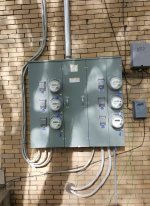That guy is an idiot and I dont trust him at all. But seriously, I think there are two approaches that are being thrown around. One is the "transition" approach where we change from a cable to a conductors in raceway. The other is the 'sleeve" approach. I am fine with the former and dont see any ambiguity. The latter is what I am unclear on and how we get around the securing requirements:
334.30 Securing and Supporting. Nonmetallic-sheathed cable shall be supported and secured by staples; cable ties listed and identified for securement and support; or straps, hangers, or similar fittings designed and installed so as not to damage the cable, at intervals not exceeding 1.4 m (41 ∕2 ft)
and within 300 mm (12 in.) of every cable entry into enclosures such as outlet boxes, junction boxes, cabinets, or fittings. Flat cables shall not be stapled on edge. Sections of cable protected from physical damage by raceway shall not be required to be secured within the raceway.
The wording is interesting and perhaps we can call the TA with bushing a fitting and the 12" securing requirement starts there?



